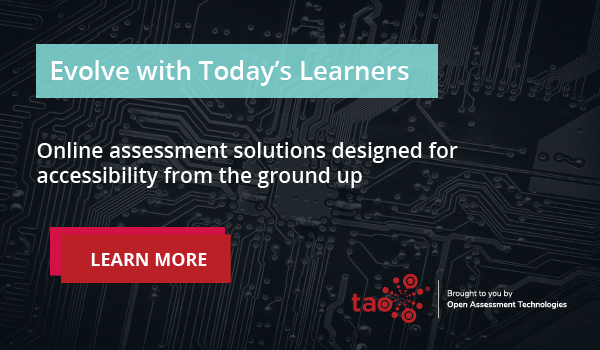In traditional learning environments, instructors may exhibit unconscious biases that, while entirely unintentional, negatively affect learning outcomes for certain groups of students. Instructors may demonstrate bias toward students based on gender, race, socioeconomic status, ability, and various other identifying characteristics.
As remote learning grows in popularity, it’s tempting to assume that a lack of face-to-face interactions will reduce the prevalence of bias against these students. However, research indicates that instructors and classmates still show their biases through their interactions in online learning environments. For example, a Stanford study found that ” instructors are 94% more likely to respond to a discussion forum post by a caucasian male than by any other race-gender combination.”
Online assessment is another key aspect of remote learning in which biases against certain groups of students can lead to negative learning outcomes. If students can’t access assistive tools or don’t understand the cultural context of a question or problem on their test, their grades will likely suffer the consequences.
As a result, instructors must make deliberate efforts to eliminate biases in remote testing systems. This blog includes tips to help you avoid biases and promote equal learning opportunities in your online assessments.
Create Accessible Content
In many ways, online learning offers differently-abled people a more equitable environment through flexibility and assistive features that help them participate in courses more easily.
While online testing can benefit individuals with disabilities, it can actually become a hindrance if assistive technologies are improperly implemented or even left out altogether. Students can ask a teacher for assistance or explain the need to postpone or even adjust an assessment in the classroom. In remote courses, it can be more challenging for students to address testing roadblocks when, in fact, assessments and other course tools should be accessible to them in the first place.
To provide students with an accessible online assessment, ensure your systems follow accessibility regulations and provide test-takers with assistive technologies like screen readers, speech input software, and more. You should also make sure your testing system is compatible with personal tools these students may need to use during a test. Assess your system’s lockdown features and ensure any security measures won’t prevent students from using the assistive tools they need to take a test.
Implement Monitoring Tools
It’s challenging for a single instructor to watch upwards of 30 test-takers simultaneously in a classroom. In distanced learning, test fairness and security take high-priority as teachers adjust to new monitoring tools and processes.
Instructors need a monitoring program that ensures students are honest during each online assessment:
- Do they have additional tabs open on their computer?
- Are they checking notes offscreen?
- Are they chatting with a classmate or parent during the test?
Automated proctoring and monitoring tools provide students with fair, closed-book assessments outside of the classroom and reduce human error during proctoring or grading. They ensure that each student is given an equal opportunity to succeed by monitoring every test-taker the exact same way.
A computer monitors all mid-test activities carefully as opposed to a human proctor who may not notice a student peeking into their notes or whispering to a classmate. When tests are complete, automated scoring tools ensure students don’t miss points due to an accidental ‘x’ of their teacher’s red pen or even a biased assessment of free-response questions.
These tools also track and measure scores across classes, eliminating the need for time-consuming hand scoring and helping track individual learning outcomes at the student level. They also allow teachers to analyze student data easily, understand overall class performance, or identify specific patterns in engagement or understanding of a particular subject within a single exam.
Efficiency and accuracy are at the forefront of measuring assessment success. AI allows students to define a problem and find a solution — leaving the educator with clear data on how to proceed both during the instruction and future tests.
Personalize Testing Materials
In the world of education, instructors have learned that one size doesn’t fit all. Legacy curriculum and memorization-focused testing methods don’t accurately measure students’ understanding of the course material or subject matter.
To provide students with a value-driven, accurate learning experience, remote instructors are implementing adaptive testing tools. Adaptive tests present questions based on a student’s previous answers, engagement level, and learning style.
Personalization technology delivers tests that keep students engaged and assess their true understanding of a subject, not just their ability to memorize facts or regurgitate familiar vocabulary terms from a lesson. These tests provide every student with an equal opportunity to succeed and eliminate potentially offensive, outdated, or culturally-specific questions from assessments.
Augmented and virtual reality technologies are another way instructors can provide real-world scenarios that allow students to demonstrate knowledge beyond yes/no or multiple-choice responses. These AI tools present students with more information, experience, and technical approaches than traditional exams.
User Testing Matters
In online assessment, the only way to truly guarantee accessibility is to look for systems that involve user research and testing, where people of different abilities — with various access needs — have used the testing system to provide feedback to developers. Applications that employ a wide range of users with differing abilities and include built in WCAG 2.1 A and AA standards help ensure that your platform is designed for accessibility from the ground up.
—
Ultimately, your online assessment system should provide equitable testing for all students through accessible features, equitable monitoring processes, and adaptive questions based on students’ experiences and learning styles.
Contact us to find out how our online testing solutions can promote equal learning opportunities for your school.


